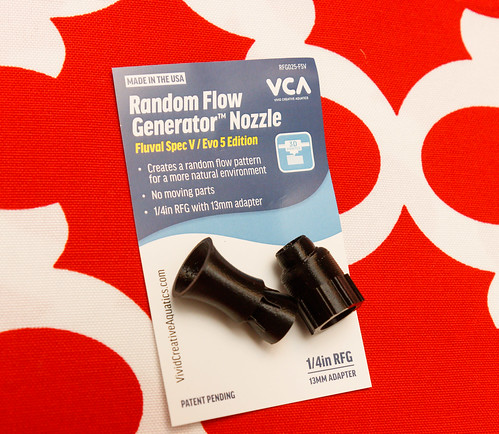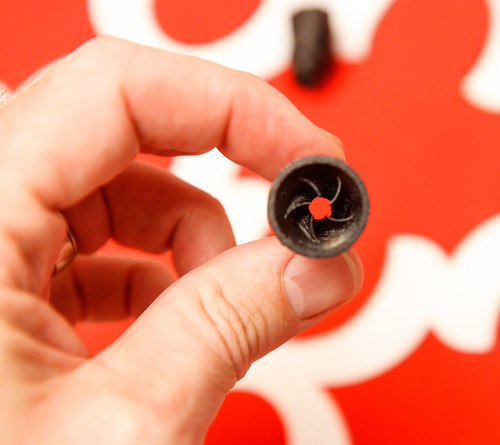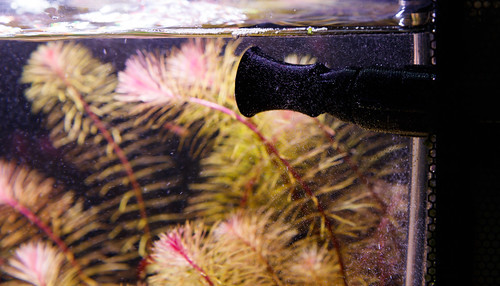I have not given much consideration to the flow performance of our Spec V aquarium, but as I transitioned to a High Tech Planted setup, I started to wonder if our tank would benefit from better flow characteristics.
One upgrade that caught my eye when researching for our Saltwater EVO is a Random Flow Generator made by Vivid Creative Aquatics (VCA). This is a return flow nozzle that is designed to create varying flow patterns. I discovered that VCA makes a version of their Random Flow Generator for the Spec V (it would also work for the Spec III and the saltwater EVO V) and I thought that it would be worth testing to see if it is a desirable upgrade for this All-In-One nano.
What Does a Random Flow Generator Nozzle Do?
A Random Flow Generator differs from a standard return nozzle in that it creates flow patterns of varying intensities and directions. This product line originated with saltwater tanks as they typically want varying flow to simulate the wave conditions in a reef.
How Random Flow Generator (RFG) nozzles work is a bit of a mystery, but it’s explained well in this VCA webpage:
“The Random Flow Generator™ Nozzle is the ONLY random flow generating device on the market with no moving parts. The patent pending design uses fluid dynamics to vary both the intensity and direction of the flow, as it exists the nozzle. This means it will never get stuck, stop working or require internal maintenance.”
“The internal structure of the RFG Nozzle is comprised of a 5-vane helix that spirals nearly the entire length of the nozzle with a central jet. Each vane of the helix is connected to an eductor at the base. Together, they form a set of internal channels. These channels along with the center jet, work together to pull the flow in one direction or the other as it exits the nozzle creating he randomization effect.”
The key to how the RFG works is the ‘eductors’ (which are the openings you see at the back circumference of the nozzles) and the internal channels formed by the nozzle’s construction. This causes water flow to stall out and speed up when induced through the channels.
 The beauty of VCA’s Random Flow Generator is that it has no moving parts. It is constructed by a 3D printing process (as do many of VCA’s products) – I will discuss a bit later about the impact of 3D printing on this product.
The beauty of VCA’s Random Flow Generator is that it has no moving parts. It is constructed by a 3D printing process (as do many of VCA’s products) – I will discuss a bit later about the impact of 3D printing on this product.
The benefit for reef aquarists in using a RFG nozzle is to get more variation of flow through the tank. This can assist the effect of a separate wavemaker power head or it may even be the goal for the RFG Nozzle to replace entirely a separate wavemaker. This could be a great benefit for a small nano reef where space for a separate power head is not desired.
Installation of VCA’s Spec V Aquariums Random Flow Generator:
The Random Flow Generator for the Spec V is basically a 1/4″ sized RFG nozzle coupled with a specially designed transition piece to fit over Fluval’s stock elbow that penetrates through the black plastic wall. It is VCA Model RFG025-FSV.
To install, you just need to take the two pieces provided by VCA and press them together. The two pieces, once joined by a press fit, are stationary. This is different from a traditional Loc-Line fitting where the nozzle would be able to be rotated to change the direction.
Next, you remove the stock Fluval return nozzle by pulling it out of the elbow piece. Next, press the VCA assembly over the protruding elbow.
If you want to change the direction of the flow, you can rotate the VCA nozzle around the (stock) elbow. It’s not the same articulation and adjustment you get with standard Loc-Line fittings, but it’s good enough.
This brings us to the first drawback of the product. It has a texture typical of any 3D printed part – it’s surface has very small ribbed peaks and valleys. The manufacture is not as precise as an injection molded part. This is not a big deal at all, except that in this application, the interference (press) fit between the VCA nozzle and the Fluval elbow is not tight enough.
The first time I installed it was moderately tight. However, after a few install/remove cycles, it became so loose that it wouldn’t stay on and ended up blowing off and resting on the bottom of the aquarium. I think the issue is that the 3D ribbed texture becomes worn down (the peaks get worn off) after the first install. After that, the inside diameter was too large and the part fits loose.
The fix that I read on another user review was to place a small piece of electrical tape at the junction between the VCA piece and the Fluval elbow to take up slack and make the nozzle stay put. This is not ideal. I think it’s just a byproduct of the lack of dimensional control for 3D printed parts. It would be interesting if VCA could make a rolling change and modify the inside diameter slightly smaller. Or perhaps, machine the offending surface with a post print process to make it a more precise fit.
Flow Characteristics of the Spec V Random Flow Generator:
I’ve seen several videos, including those presented on Vivid Creation Aquatic’s website, that show the random flow of their nozzles in action. However, all of those videos are for larger nozzles (1/2″, 3/4″ or 1″). I don’t observe this dramatic pulsing or wave action with this smaller RFG.
However, it definitely changes the flow characteristics in the tank. I have a CO2 injected tank by way of an in-tank diffuser that is located below the return nozzle. This mist of CO2 bubbles lets me ‘see’ the flow inside the tank.
Below is a video comparing the stock Fluval Spec V Nozzle with the Vivid Creation Aquatic’s RFG:
I found something interesting in the manufacturer specs for this RFG:
- Model: Single 1/4in RFG (RFG025-FSV)
- Minimum Flow: 80-100 GPH
- Suggested Optimal Flow: 120-140 GPH
- Recorded Maximum GPH: 225 GPH
A point to note is their listed minimum flow of 80-100 GPH. When I tested the flow of the stock Spec pump (in my Spec III review) it came to around 26 GPH, which is well below the manufacturer’s recommended flow.
Granted, VCA’s nozzle is less restrictive so I’d expect it has higher flow than what I tested with the stock nozzle; however, it would still be well below their listed operating range of flow rates.
I think this is part of the problem with it not displaying much in the way of wave action. The deficiency is divided between the small 1/4″ nozzles inherently pulsing at a higher frequency (compared to the larger 1/2″, 3/4″, or 1″ nozzles) and the Spec’s low flow stock pump.
I have a higher flow Cobalt MJ Mini 606 pump that I have now installed on our Spec V. I will offer a separate review of this pump upgrade in the future and will report on the effect it has in operation of the Random Flow Generator.
Is the VCA Random Flow Generator a Shrimp Killer?
That’s an odd question – right? Well, on more than one occasion, I have walked by our tank and noticed a hapless shrimp jammed, rear end first, into the back end of the RFG nozzle. I’m talking about those educator openings I spoke of earlier.
Those openings have enough suction, and shrimp are curious enough (and dumb enough) to somehow get drawn into that and get stuck.
I finally discovered a way to get them out with as little hassle (for them and me) as possible: hold your finger over the end of the nozzle (where water discharges). This will cause pump flow to reverse backwards out of those educator openings, and will thus blow the shrimp out the back to freedom. Some shrimp have swam off simply dazed, other’s have a less desirable fate of being food for their relatives. Oh well, glad they breed like cockroaches in our tank.
The finger-over-nozzle trick is also very handy to free plant clippings that sometimes jam up the nozzle.
Final Thoughts and Recommendations for VCA’s Random Flow Generator Nozzle:
There are a few con’s to VCA’s Random Flow Generator for Fluval Spec Aquariums:
- Fit/Finish could be better, specifically the issue where it won’t stay installed and requires tape to keep it in place.
- The small size (based on a 1/4″ nozzle) doesn’t translate well as a true ‘wavemaker’; the random flow it creates is high frequency and not visually much different than stock.
- At around $20 USD, it is not a particularly cheap upgrade (especially considering the aforementioned manufacturing issues).
Having said all that, for our tank, I’m glad I got this RFG and consider it a good upgrade. I’m looking for any advantage I can to move water (and the CO2 we are injecting) around to every part of the tank. I can see by how the CO2 bubbles travel through the aquarium that it makes a difference to reach parts of the tank it previously did not. I also like the extra back and fourth movement I see in our stem plants.
If you are looking at this for a saltwater EVO, I’d say it makes sense as a relatively easy way to get some additional movement in your reef.
As I alluded to earlier, this upgrade was made much more effective by upgrading the stock Spec V pump – I will discuss further in my Cobalt MJ Mini 606 pump review.









Great write up! I was looking forward to this one as I feel like the Spec V is a great tank but can benefit from flow. A problem I continue to have in mine. Can’t wait for the article on the Cobalt MJ Mini 606! What do you have stocked in your Spec V for fish? I see shrimp and maybe Chili Rosbaras?
Thanks for the encouragement! Fish in the Spec V have been in flux this year. Yes – I had Chili Rasboras but they succumbed to ich at the start of the year. I just restocked with green neons and they are doing great.
Thanks Nate! Any chance of an upload of a current full image of the Spec V? Would really love to see where it is at.
Thanks for the interest. Tank looks good – I’ll try to post an update soon.
Nate, I stumbled appon your website and this review this morning. It was very well written and your photos and videos are top-notch.
I wanted to say thank you for such thorough and honest review. Its this kind of product review that can both help the hobbiest considering a product as well as help the manufacure of that product with real-world user experince information.
Regarding the loose fit of the adapter you encountered. We have noticed that the elbow the adapter attaches to actually has a small veration in the OD of the two ends. If the adapter fits loose, you may try flipping the elbow and attracting the adapter to the opposite end. This will usually fix this sort fitmemt issue on this tank. If not, then please contact us and we’ll be happy to replace it and get you one that has the propper fit.
The Random Flow Generator(R) Nozzle definetly needs to be provided the right amount of flow to get the full benefits of the unique randomized flow its capable of creating. In the SpecV that can be challenging given the small pump chamber.
In our own SpecV tank we opted for the Hydor Pico Evo pump and use it as the return pump. It is a tight for and maybe not ideal becuase the way it has to be positioned to fit in there, so I’m looking forward to you upcoming review with the updated pump.
Antonio – Thanks for the comment and feedback! I will try out of curiosity the trick of trying the other end of the Fluval 90° elbow – I’ll be surprised if that does it, but I will try it and let you know.
The Cobalt MJ Mini 606 pump is very good, with a few caveats that I will post in an upcoming review. Thanks for the alternative suggestion of the Hydor Pico EVO.
I’m using your 1/2″ Loc Line Random Flow Generator on our Fluval EVO – It’s wonderful and in every way a recommended upgrade. I will get that review out in the new year!
Hello! Thank you so much for all of the information. I am finishing doing a custom bookshelf and once finished I wanted to put a planted betta tank as we have not had an aquarium in several years. Last aquarium was a saltwater tank and I was looking for something that was a little less work. Your information on modifying this aquarium has been great and exactly the information that I have been looking for online. Ok, to the question. I am wondering if you think that this random flow generator is too much flow for a betta tank?
Thanks so much!!
A Random Flow Generator won’t necessarily be ‘too much’ for a Beta as it doesn’t increase flow, it just changes the flow characteristics. Having said that, not sure it will benefit the Beta much (or any). I’d get the tank setup with the stock flow nozzle and observe how the fish does.
Greetings. Your blog has been an immense help with my new Spec tank. With your guidance I am quite happy with my set up. I was interested in your pump review but have not seen it. I just upgraded my pump to the PULACO 90gph but don’t see much change. I was curious if the 606 was any better? I have mostly shrimp and chili rasbora and moderately planted with moss, dwarf grass, and a few stem plants. I don’t want to blow them around, but I know the more I can cycle through the filter, the better the tank can handle bioload. I have upgraded the filter with media baskets. Is the 606 an improvement or is the flow too much for inhabitants? I also have the VFG nozzle installed. I used a low flow waterfall nozzle but had to combat surface film with the lack of agitation.
I’ve hesitated making the review of the Cobalt Mini MJ 606 pump for three reasons: It’s not readily available, it’s a bit too much flow for any Spec tank, and it requires some mods to fit in the Spec V pump section.
I’m not familiar with the PULACO 90gph.
PULACO makes a 50gph which is a drop in for the Fluval pump. The 95gph is very similar in size but requires you to trim the flow control lever to fit. I don’t have a way to measure the actual output flow in the tank, but the drawdown in the pump chamber implies it is more than the stock pump. I tried it with the RFG but noticed little to no difference in flow pattern vs the stock nozzle. I also noticed the drawdown in the pump chamber was less with the RFG which would imply it reduces total flow from the turbidity. I switched back to a waterfall nozzle to get my flow back up. I’m trying to find a good trade off with high flow for more cycles through the filter media, more surface agitation to combat film, and low current in the tank for the livestock. I thought if I increased the pump output, I might get better flow randomization. It sounds like the 606 would be too much. I have a PULACO 160gph on its way. It should fit if I remove the front and back covers. I can let you know once I get my hands on it.
All of your concerns sound familiar. It’s quite challenging balancing everything to get good distribution, not too much to wear out all the critters, and yes . . knocking down the surface scum.